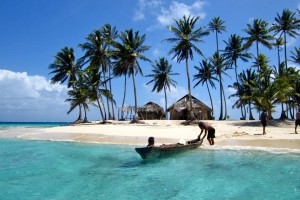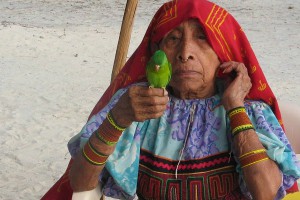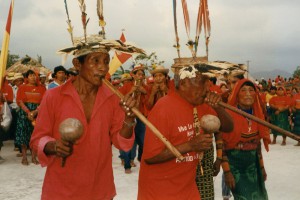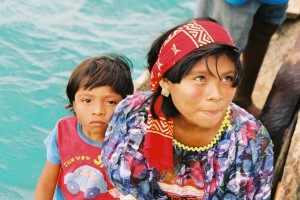The Guna
 It is pronounced Kuna although it is written Guna.
It is pronounced Kuna although it is written Guna.
Nobody knows for sure when they arrived in Panama. Modern theories suggest they probably arrived from South America and other contradicting theories mention they did it from the Caribbean Lesser Antilles. By the 16th century, they had already occupied the 365 islands known today as the San Blas Archipelago or “Guna Yala” in ther native language. Pushed from mainland towards the Caribbean coast by enemy Native American tribes and the Spanish conquistadors. Today, The Gunas are mainly found on the islands of San Blas, but also in the jungle of Chucunaque and Bayano.
 The Gunas have struggled for centuries to keep its culture and traditions alive. During the colonial period, they joined European corsairs and pirates in a number of successful attacks against the Spanish, who had vowed to eliminate them. As the Spanish empire dwindled, they became entrenched in the regions of present-day Darién and San Blas, in Panama, and western Colombia, which granted them lands and legal recognition towards the end of the 19th century. Panama, which back then was a Colombian province, declared independence in 1903 and ignored the agreements. Although most of The Guna population was on the Panamanian side of the border, a fact that made many inhabitants of San Blas side with the Colombian government just as Panamanian authorities sought to “civilize” the Guna.
The Gunas have struggled for centuries to keep its culture and traditions alive. During the colonial period, they joined European corsairs and pirates in a number of successful attacks against the Spanish, who had vowed to eliminate them. As the Spanish empire dwindled, they became entrenched in the regions of present-day Darién and San Blas, in Panama, and western Colombia, which granted them lands and legal recognition towards the end of the 19th century. Panama, which back then was a Colombian province, declared independence in 1903 and ignored the agreements. Although most of The Guna population was on the Panamanian side of the border, a fact that made many inhabitants of San Blas side with the Colombian government just as Panamanian authorities sought to “civilize” the Guna.
The Guna Revolution
 The resentments reached a climax in 1925, when Richard O. Marsh, a Canadian adventurer, motivated the Gunas to declare the independence of Panama by creating the “Republic of Tule.” A peace treaty was later signed, and the Guna agreed to recognize Panamanian sovereignty only after the “wagas” (the no-gunas) granted them a good deal of autonomy. Today, the Panamanian authorities rarely interfere with the Guna government and have created three special “comarcas” for themselves. The Guna have the most advanced political system of any other indigenous group in Latin America.
The resentments reached a climax in 1925, when Richard O. Marsh, a Canadian adventurer, motivated the Gunas to declare the independence of Panama by creating the “Republic of Tule.” A peace treaty was later signed, and the Guna agreed to recognize Panamanian sovereignty only after the “wagas” (the no-gunas) granted them a good deal of autonomy. Today, the Panamanian authorities rarely interfere with the Guna government and have created three special “comarcas” for themselves. The Guna have the most advanced political system of any other indigenous group in Latin America.
The Mola
 The Guna women wear hand-sewn skirts and blouses known as “molas.” La Mola is an intricately stitched pattern made of layers of fabric in a reverse applied technique. The men wear a traditional Guna shirt and less traditional pants like jeans, or shorts. Guna women also paint their faces with a homemade blush made from achiote seeds. They also usually wear a nose ring and paint a line on their nose.
The Guna women wear hand-sewn skirts and blouses known as “molas.” La Mola is an intricately stitched pattern made of layers of fabric in a reverse applied technique. The men wear a traditional Guna shirt and less traditional pants like jeans, or shorts. Guna women also paint their faces with a homemade blush made from achiote seeds. They also usually wear a nose ring and paint a line on their nose.